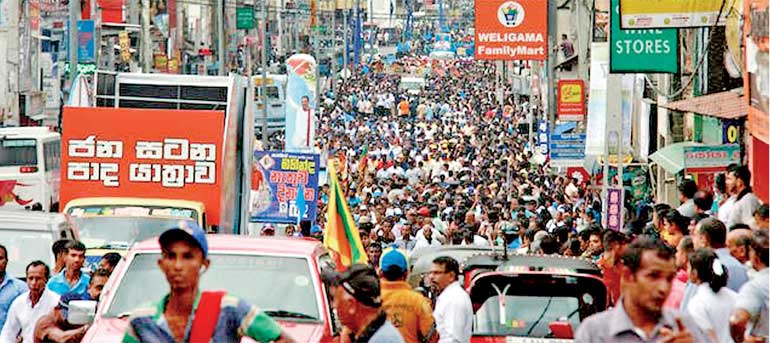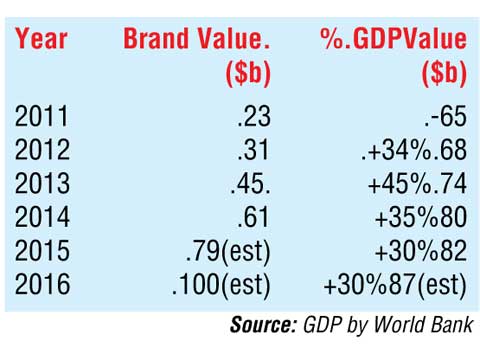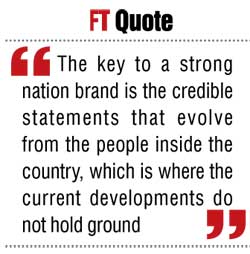Wednesday Apr 16, 2025
Wednesday Apr 16, 2025
Tuesday, 2 August 2016 00:05 - - {{hitsCtrl.values.hits}}
Believe it or not, the estimated brand value of $ 100 billion plus is said to beat the GDP value of Sri Lanka in 2016, given the strong democratic Government that came into power on 8 January last year.
What this performance means is that the country is poised to attract better quality tourists, higher FDI and stronger access to global markets. However, the reality is very different given that we see global media dominated by negative media stories from arrests to Opposition rallies, which is certainly denting brand Sri Lanka.
 The Paada Yathra by the Joint Opposition will sure hurt brand Sri Lanka
The Paada Yathra by the Joint Opposition will sure hurt brand Sri Lanka
From a very practical point of view, while we can be proud of the GDP growth numbers during the last five years and the corresponding value of the nation brand picking up by 35% year-on-year, what is alarming is the recent upheaval that is happening from students, teachers, trade unions hitting top media sites and digital media points that is making these stories goes viral, which is hurting the 100 billion dollar brand.
As I pen this piece, the Paada Yathra by the Joint Opposition is a classic example of the mixed signals emitting to the world from Sri Lanka.
What is sad is the content stories that are getting flashed on global media from the alleged Central Bank bond issue, coal scam, etc., which is certainly hurting the brand identity of Sri Lanka on the global stage When it is estimated that 2016 should surpass the $ 100 billion value, as the respected economist Razeen Sally voiced last week ‘Sri Lanka is losing the opportunity again’.
If I may track back from 2011 onwards, the value of brand Sri Lanka has picked up post the war coming to a close up from $ 23 b (2011) to $ 31 b (2012), $ 45 b (2013), $ 61 b (2014) $79 b (2015), which is on an average growth of around 35% year-on-year, which means that we will end 2016 at around the $100b+ mark.
On the other hand, the GDP value which was $ 65.2 b (2011), $ 68 b (2012), $ 74.2b (2013), $ 80.2 b (2014) whilst in 2015 registered $ 82.1 b. It is estimated that Sri Lanka’s nation brand value will beat GDP value somewhere between 2016-2017 which is an interesting insight but the upheaval we see continuously is definitely hurting the brand on the global stage.
The million dollar question asked by many is whether democracy should be exercised to this extent in an island nation or if ‘a dictatorial government’ is a better model, but not with brutality.
To my mind, it is not the debate between these numbers that is important but the implication of this insight for us in business. Nation  branding global expert Simon Anholt always highlighted that nation brand building is not about launching sexy advertising or catchy taglines like ‘Wonder of Asia’, ‘Land Like No Other’, etc. He emphasises respect in the global stage is earned with a series of actions over a long period of time, rather than just orchestrated activity.
branding global expert Simon Anholt always highlighted that nation brand building is not about launching sexy advertising or catchy taglines like ‘Wonder of Asia’, ‘Land Like No Other’, etc. He emphasises respect in the global stage is earned with a series of actions over a long period of time, rather than just orchestrated activity.
But, as cautioned by Anholt, the expert of brand building, the key to a strong nation brand is that it is not a strategy that can be implemented but it is a credible statement that evolves from the people inside the country, which is where the current development does not hold ground.
Research reveals that if one is to develop a strong nation brand globally, the foundation is to have a strong partnership between the policymakers in the ministry and the private sector so that the private sector takes the message to the world on the positive aspects of working in Sri Lanka.
Especially in a country like Sri Lanka, where 75% of the economy is accounted for by the private sector, if the private sector and people keeps generating messages which are not in line with the overall DNA of the nation brand, it only colours the identity of a brand.
The best cases in point globally of countries that have excelled on this front are Croatia and Estonia. Whilst this is the ‘best practice’ the world is hearing from, Sri Lanka capturing world attention which is of a mixed note in nature is not supporting the country brand building thrust sadly.
If we get to the specifics, if we Google Sri Lanka, we see the top stories are all negative in nature. From the many protest campaigns to the alleged corruption issues of the current Government and then the many arrests from past kickbacks such as the Krrish deal to  Shangri-La payments, all of it is clouding world perception.
Shangri-La payments, all of it is clouding world perception.
In the backdrop of Sri Lanka’s GDP being outstripped by the nation’s brand value, the confusing mixed signals from the country are coming in between the positive impacts that that the country can accrue.
Whilst a strong nation brand building campaign can somewhat outsmart the SOV on the world stage, nation brand building expert Simon Anholt advocates as mentioned before ‘a country earns an image based on actions they execute on a day-to-day basis and glitzy advertising campaigns does not do anything to its credibility’.
I cannot agree more with this hypotheses given the empirical evidence we see from strong nation brand building initiates that have happened in Croatia and Estonia in the recent history of the world. I guess it’s time the policy makers take this cue.
For a country like Sri Lanka, challenged by the alleged war crimes during the final phase of the war, negative lobbying by the diaspora on issues like returning the land grabbed by the forces during the war and the thrust by the current Government on corruption by the previous regime whilst the contagious VAT uproar are the actions that are getting captured by world media, demonstrating the actions out of brand Sri Lanka.
This totally negates the brand value earned over time. Maybe it’s time to form a nation brand building committee so that to some degree sanity can be made to prevail, despite the many internal challenges.
Let me share a few thoughts on the best practices from other country brands and the probable action that we must follow, given the mixed vibrations that we are emitting to the world stage.
1) Investment: From an investment point of view, it’s best we study the best practices that the world saw in 2015. The best strides the world has seen was from countries like the Philippines and the UAE. Even with the strong initiatives from the above, Singapore remained the top country in this indicator due to the constant nature of its actions over time. It will be interesting to see the impact that the UAE will make in 2020 after hosting the World Expo. Maybe Sri Lanka also needs a big bang activity like this to get world attention.
2) Tourism: Sri Lanka was ranked highly for making strides after procuring a peace dividend, which is very interesting. However, given the global image building campaign being a nonstarter for the last two years, we have failed to profile the country so that we can attract the top dollar tourists rather than the current one hundred plus number driver.
Let’s not forget that the cost of the war on tourism earnings between 1990 and 2009 is a staggering $ 6 billion dollar loss for Sri Lanka. Today we are touching almost $ 2.9 billion in tourist income and are targeted to reach 2.2 million tourists in 2016 but the fact of the matter is that Sri Lanka does not have a carrying capacity to support such a vision. The top ranked destination, as per Brand Finance score, is Thailand. We need to take a cue from the $ 25 billion advertising budget of Thailand unleashed whilst also allocating an infrastructure development budget so that the promise advertised can be delivered on the ground. Sri Lanka is losing the  game in both forms sadly.
game in both forms sadly.
3) Goods and services: Germany had made the best strides in 2015 as per the pickups from Brand Finance but the top rank country is still the US, which explains the power of the ‘Brand USA’ push of the country after 238 years.
The Sri Lankan apparel industry dominance in the USA is an opportunity to touch the world consumer. If one does a deep dive on brand USA, we see that brands like Apple have contributed significantly to the overall country brand. Sri Lanka has ‘Ceylon Tea’ but sadly, the story has not been told well to the world and it is not helping the country strategy.
4) People and skill: Finally, on the area of people and skill, Switzerland was the best in class in 2015 but the recent surge by the UAE was interesting given that the country attracts the talent of the world with a controlled economy. Second place going to Singapore is interesting. Sri Lanka registering an unemployment rate of 5.2% means it has a serious skill gap given the country objectives of apparel targeting $ 10 billion from the current $ 5 b, tea targeting three billion dollars from the current 1.7 b, the BPO business to become one billion dollars from the current 0.4 b and tourism $ 10 billion from the current $ 2.9 b is almost impossible unless we import talent from countries like Bangladesh and China.
Whilst Sri Lanka can be proud of the overall number game on GDP and brand value, the fact of the matter is that the current upheaval of the masses by way of protest campaigns does not augur well for brand Sri Lanka even though the estimated value is said to cross $ 100 billion this year. I guess time will tell.